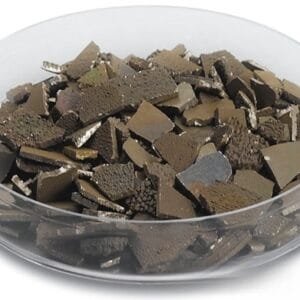When it comes to advanced thin film deposition processes, having the right materials is essential for achieving high-quality coatings and consistent results. Thulium(III) oxide (Tm₂O₃) is a rare earth oxide with exceptional properties, making it an ideal material for various applications in the fields of optics, electronics, and more. TFM offers premium Thulium(III) Oxide Evaporation Materials designed to meet the rigorous demands of vacuum deposition systems.
What Is Thulium(III) Oxide and Its Role in Thin Film Deposition?
Thulium(III) Oxide (Tm₂O₃) is a high-purity, white, and highly stable material composed of thulium, a rare earth element, combined with oxygen. It is widely used in thin film deposition processes due to its unique optical and electrical properties. In particular, Tm₂O₃ is commonly employed in applications such as:
Optical coatings (antireflective coatings, mirrors, etc.)
Electronics (semiconductor devices, laser materials, etc.)
Phosphors for display technologies
Magnetic materials for specialized applications
Surface coatings in aerospace and military technologies
Why Choose Thulium(III) Oxide Evaporation Materials from TFM?
At TFM, we provide high-quality Thulium(III) Oxide Evaporation Materials, specifically designed for use in vacuum deposition processes. Our products are manufactured with precision and care to ensure high performance and consistency, enabling your systems to achieve the optimal thin films required for your applications.
Specifications of Thulium(III) Oxide Evaporation Materials
| Material Type | Thulium(III) Oxide |
| Symbol | Tm2O3 |
| Color/Appearance | Greenish-white cubic crystals |
| Melting Point | 2,341 °C |
| Theoretical Density | 8.6 g/cm3 |
| Purity | 99.9% ~ 99.99% |
| Shape | Powder/ Pellets/ Granule/ Custom-made |
Key Features of TFM’s Thulium(III) Oxide Evaporation Materials
High Purity: TFM’s Thulium(III) oxide is produced with exceptional purity to ensure reliable results and minimize contamination during deposition.
Stable and Consistent Evaporation: Our materials are formulated for consistent evaporation rates and stable deposition processes, ensuring high-quality thin films.
Versatile Applications: Suitable for a variety of deposition methods, including electron beam evaporation and resistive thermal evaporation.
Advanced Packaging: Carefully packaged to preserve material integrity and prevent contamination, ensuring a smooth deposition process.
Applications of Thulium(III) Oxide Thin Films
Thulium(III) Oxide is an essential material for several cutting-edge industries, and its thin films have significant applications in the following areas:
Optical Coatings: Thulium(III) oxide is used in the creation of antireflective coatings for lenses, mirrors, and other optical components, thanks to its excellent optical properties.
Semiconductor Industry: Thin films of Tm₂O₃ are utilized in the fabrication of semiconductor devices, offering high-performance materials for electronics.
Laser Materials: Used in the production of lasers and laser components, thulium oxide thin films exhibit favorable characteristics for laser emission and amplification.
Phosphors for Displays: Tm₂O₃ thin films are incorporated into phosphor materials, used in technologies such as flat-panel displays and light-emitting diodes (LEDs).
Magnetic Coatings: Its magnetic properties make Thulium(III) oxide ideal for specialized coatings used in magnetic devices and data storage applications.
Why TFM for Your Evaporation Materials?
TFM has a long-standing reputation for providing high-quality materials for vacuum deposition systems. Our Thulium(III) Oxide Evaporation Materials are trusted by industries worldwide due to:
Uncompromising Quality: We ensure the highest standards in material purity and consistency, meeting stringent industry requirements.
Customized Solutions: Whether you need standard or specialized formulations, TFM offers custom materials to suit your specific thin film deposition needs.
Technical Support: Our team of experts is always available to provide guidance on choosing the right materials and optimizing deposition processes.
Global Reach: TFM delivers to locations worldwide, ensuring that your projects stay on track with timely delivery and reliable service.
Request Your Thulium(III) Oxide Evaporation Materials Today
If you are looking for high-quality Thulium(III) Oxide Evaporation Materials for your deposition processes, TFM is your trusted partner. Our materials ensure consistent, high-performance coatings that meet your exact specifications.
Contact us today to request a quote, get detailed product specifications, or discuss your specific application needs. Experience the difference with TFM’s premium Thulium(III) Oxide Evaporation Materials!


 MSDS File
MSDS File



Reviews
There are no reviews yet.